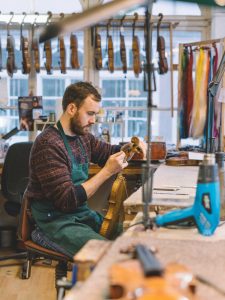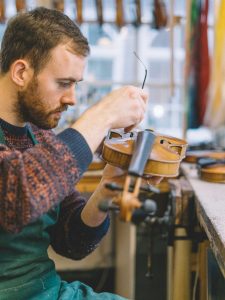Our Instrument Set Ups
Purchasing your first instrument is often a daunting experience. Beginners and their families often feel stressed, as they expect to have to pay a considerable amount of money for an item about which they know very little.
At Cardiff Violins we aim to make the process informative and enjoyable. The business is committed to high quality craftsmanship and integrity: we provide our customers with high quality products that are fairly priced, and we strive to educate all of our customers as to
how they should assess an instrument they potentially intend to purchase.
We regularly encounter two false assumptions made by customers wanting to purchase a beginner’s instrument:
- . A beginner doesn’t need to be too concerned with the quality of an instrument as a beginner doesn’t possess the expertise required to assess the quality of an instrument, nor appreciate its value. This assumption, unfortunately, leads to many beginners abandoning their study of their instrument, as instruments that don’t function well make it impossible to progress to the point of playing competently. The information provided below can assist you in assessing instruments to ensure they function correctly.
- . The higher the price, the higher the quality of an instrument. Many retailers tell beginners that an instruments price represents its quality, whereas it’s only an indicator. There are multiple factors governing the price at which an instrument is valued; beginner’s instruments prices vary considerably based on the country in which the instrument was made. No instrument will function well without having been set up by a knowledgeable luthier (this ensures all aspects of the instrument are correctly sized & fitted i.e strings at the correct height, bridge fitted and shaped correctly). New Chinese instruments priced at £250 that have been set up correctly will sound much better than an antique violin priced at £1500 that is poorly made and set up incorrectly.
Our set up process enables beginners to buy an affordable instrument that functions well
We recommend beginners buy an affordable, well-made instrument that has been set up correctly by an experienced luthier. We select instruments by carefully assessing the quality of workmanship possessed by the maker and the quality of the materials used. We set up instruments to ensure all parts of the instrument function correctly. Listed below are the parts of instruments that are often poorly made or fitted, and the work we carry out to ensure they function correctly.
We also ensure intermediate level players who don’t want to spend too much on their next instrument have a broad range of affordable instruments to select from that meet the demands of performing intermediate repertoire
Players at intermediate level have different concerns than those at beginner level, but intermediate players who are unsure as to whether they wish to continue playing generally don’t want to spend a significant amount of money when searching for a new instrument, yet often require an instrument that projects to a greater degree than their beginners instrument in order to perform at a higher level when performing solo or in ensembles. As the player’s skill develops, they realise the limitations of a beginners instrument and wish to play an instrument with the potential to generate a broader range of tonal qualities. We ensure we always have a large range of instruments suitable for those at intermediate level, and that the instrument is set up to ensure every part of the instrument functions well, and the instrument performs to its full potential. The tonal quality of these instruments is at the level of antique instruments that are generally priced considerably higher.
Pegs
During transit, instruments are often subjected to changes in humidity, which if significant, results in the pegs and peg box holes changing shape. Wood expands when the ambient humidity is too wet, and contracts when it’s too dry. The peg and peg hole often lose their round shape and become oval, resulting in a string that will no longer stay in tune, as the peg and peg box hole no longer function correctly. This issue leads many beginners to quit playing, as it’s impossible to play in tune on an instrument fitted with damaged pegs. We reshape all pegs and peg holes that have warped during transit, to ensure they function correctly.
Nut
The nut is the protruding piece of wood at the base of the fingerboard, beneath the scroll, that elevates the strings above the fingerboard. The nut needs to be sized correctly, otherwise, if it’s too high, the player will have problems pressing the strings down against the fingerboard, and if it’s too low, this can result in a rattling sound being produced by the strings coming into contact with the fingerboard. The nut grooves in which the strings sit also need to be at the correct depth, as the string winding will be damaged if they are too deep. If the edge of the nut is too sharp, it will lead to pain in the player’s index finger, as well as result in damage to the strings. Our luthiers reshape and correct all nut defects, or replace the nut if needed.
Fingerboard
To function correctly, an instrument’s fingerboard needs to be subtly concave along its length (the shape of many factory made instrument’s fingerboards are too deeply hollowed, or uneven) and convex across its width. Cardiff Violins either reshape or replace an instrument’s fingerboard to ensure it’s exactly the right shape.
Bridge
An instrument’s bridge’s measurements and fitting is a hugely important component in sound quality. Fitted beneath the strings sitting atop the belly, the bridge transmits sound through the belly of the instrument. Bridges need to be fitted and sized based on parameters such as the angle of the neck and back, and the thickness and arching of the belly. Beginner’s instruments, in general, are sold with ill fitting poor quality bridges; the curve of the bridge is often too flat, which makes bow control difficult, or the height is incorrect, which results in string heights that are either too high (which causes the player extreme discomfort as the strings are hard to press down) or too low, which causes buzzing sounds. Poorly made bridges found on beginner’s instruments are often too thick and heavy, resulting in poor tone. Cardiff Violins rebridge all new instruments.
Strings
Beginner’s instruments are invariably fitted with poor quality metal strings, which produce a harsh sound. If the string height of the instrument is too high, metal strings will result in extreme discomfort for the player. Cardiff Violins replace metal strings with higher quality strings for improved sound quality and comfort.
Tailpiece
All beginners instruments at Cardiff Violins are fitted with adjustable tailpieces, or in some cases, Wittner pegs are fitted, negating the need for an adjustable tailpiece.
Soundpost
The soundpost provides structural support for the instrument, and also enhances the sound of the instrument, particularly the treble strings. The French translation for the soundpost is the ‘soul’ of the instrument, an apt name, as the dimensions and position of the soundpost have a huge impact on the quality of an instrument’s sound. All too often, sound posts are made and fitted with very little attention to the pivotal role this part of the violin plays in sound production, resulting in instruments whose voices don’t sing to their full potential. Contrary to popular opinion, there is no standardised position or size for a soundpost that is optimal for all instruments. The position and size of the soundpost both need to be tailored to the unique dimensions and tonal qualities of the instrument, as well as the preferences of the owner. Cardiff Violins adjust both the soundpost and bridge to achieve a strong and pleasant sound from all of our instruments, and we can also make adjustments on the request of the buyer based on personal preference.
Choosing the right size
To succeed in developing as a musician, buying an instrument at the correct size is essential. If the instrument is too large, it will be extremely difficult to play in tune; musicians playing on an instrument that’s too big will often contort their body to manoeuvre around the fingerboard, sometimes resulting in extreme discomfort in the neck, shoulders and arms. Instruments that are too small will cause the musician’s movements to feel restricted, resulting in discomfort, and the owner will not gain from playing a larger instrument that will be able to produce a fuller and richer sound. Cardiff Violins provide customers with information on how to assess whether an instrument fits well, and also recommends consulting with your teacher about which size to buy.
Insuring your instrument
The first act of care for your instrument is to insure it against the eventualities of loss, theft or damage. Even small accidents can cost a lot to repair, and having it insured means a lot less hassle and grief if you need to claim.

